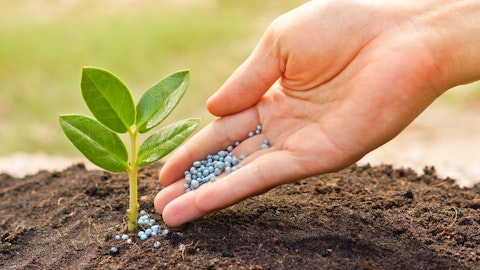And so the remaining value of those receivables on our balance sheet at September 30 was about $36 million. Our customers have continued to make good progress converting these receivables, and we have more than 60% of it already converted or in the process of being converted. So we don’t believe that really the remaining currency exposure will be anything material, depending on the ultimate exchange rates that it converts out at, it could be, call it maybe another $5 million in the fourth quarter. But like I said, nothing material. And we feel like this one is behind us and we’re – have taken the right steps to ensure it doesn’t happen again in the future. So, Pat, I don’t know any other color you want to provide on this one or the international strategy in general?
Pat Bowe: Yes. Sure. I think what I’d like to do is just kind of put in perspective. So let’s go up about 40,000 feet and look at the big picture here in our long-term strategic intent in regards to our international business. So when you think about it, consumptive demand for grains in the U.S. and Europe is flat and basically growing at the low population growth rates. While Africa and the Middle East, populations continue to grow and demand for grain and food stuff continues to increase. So this is what I’d like to call, the skate to where the puck is going to be, strategy. And we’ve sold green exports to this region for many years, but we did it through third-party companies, would then sell on to the end customer. So in a sense, what we did with our Swiss office is cut out the middleman and we’re selling directly to the end use customers in that region.
And we feel it’s really important to be close to the customer and build solid long-term relationships, especially in this region, where demand is going to continue to grow for years to come. And Brian explained the details, where we normally sell in U.S. dollars but the situation in Egypt became very difficult for any of our customers to access exchange for U.S. dollars and thus we agreed to this conversion rate. It was an unfortunate situation and result in a lot of highly unusual confluence events. We are now only doing business in U.S. dollars, so that’s not a repeatable action, have taken steps to make sure that we don’t have that happen again. And remember that would you merchandise vessels of grain they can hold 40,000 up to 60,000 tons.
At that time, a Panamax of soybeans was worth over $40 million. So this is normal in our industry as far as the volumes and shipments that were happening. And the balance of our international business has been performing very well; so kind of an isolated incident related to Egypt, that we won’t reoccur. So I would just want to reinforce that our long-term strategy of our Swiss office and our customers in that region, we’re very much committed to. We think this is a strong place to be for the long-term for our company, and this was an unfortunate event, but it’s isolated and we’ll continue to move forward with that strategy.
Brian Wright: Great. Thank you so much.
Operator: And our next question will come from Ben Klieve with Lake Street Capital. Please go ahead.
Ben Klieve: All right. Excuse me. Thanks for taking my question. A couple for me; first of all, a clarifying question on both the press release and your prepared remarks, you called out the renewables segment had $5 million of incremental merchandising business on a year-over-year basis, that $5 million on a revenue number or a profitability number?
Brian Valentine: That would be an EBT number, so profitability number.
Ben Klieve: Okay, great. Thank you. And then, Brian, you’re looking at a pretty classy problem right now on your balance sheet, the $400-plus million of cash on hand. I’m wondering if you can talk about how you are looking now at the decision between building a cash-war-chest for M&A and these CapEx projects versus paying down some of the – paying down some of your long-term debt – situation that you’ve you haven’t had to deal with for several years now. What – how is this calculus playing out in your head right now?
Brian Valentine: Yes, it’s a great question. I think right now, we have a robust pipeline of projects that we’re looking at. And when we think about even some of the things that Pat talks about in the Renewables segment. Some of these, when you start to talk about carbon capture and sequestration and some of these are – can be larger projects. We also are looking at M&A. When we think about our balance sheet and the debt position, we feel really good about our current long-term debt position. I mean, our long-term debt right now, call it, roughly 70% of it is fixed at rates below 5%. So I think a combination of being able to deploy capital into growth investments in M&A, and we also have a share repurchase authorization that is still in effect, that we will continue to evaluate in taking that balanced approach.
Pat Bowe: Maybe to build on that, I want to go back on the example, Ben, this last year, I talked about singles and doubles of bolt-ons either capital or acquisitions. We did an investment in our food corn businesses last year that we sell on to CPG companies, mainly in the chip space, that’s been executed well on time and is providing additional income right now. So creative right out the shoots. As well as two M&A projects we completed this year in Bridge Agri and ACJ pet food ingredients business. They’re both performing very well. It’s nice to have those integrated and earning above plan right out at the beginning. Again, they weren’t big, but they’re incremental and higher-return assets, we would love to continue to do projects like that.
Ben Klieve: Got it. Very helpful from both of you. Thank you for that. Plenty more discussed, but that’s probably a good place to leave it. Thanks for taking my questions, and I’ll get back in line.
Operator: And this concludes our question-and-answer session. I’d like to turn the conference back over to Mike Hoelter for any closing remarks.
Mike Hoelter: Thanks, Joe. We want to thank you all for joining us this morning. Our next earnings conference call is scheduled for Wednesday, February 21, 2024 at 11 a.m. Eastern Time, when we will review our fourth quarter results. As always, thank you for your interest in The Andersons, and we look forward to speaking with you again soon.
Operator: The conference has now concluded. Thank you for attending today’s presentation. You may now disconnect your lines.


